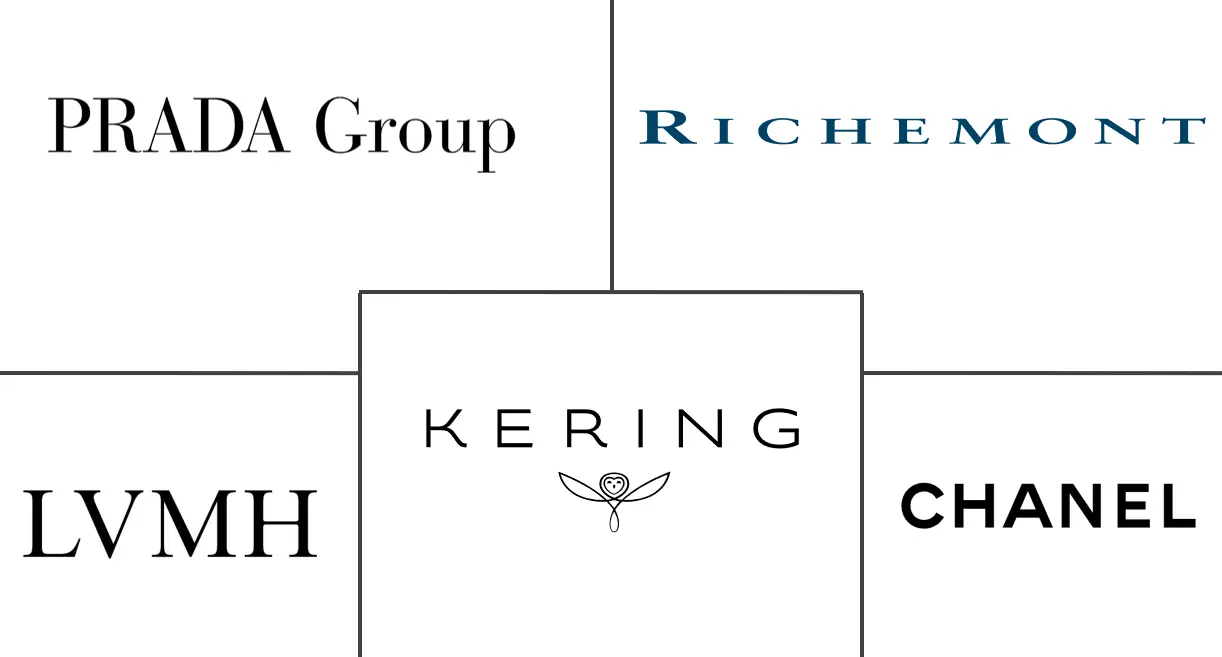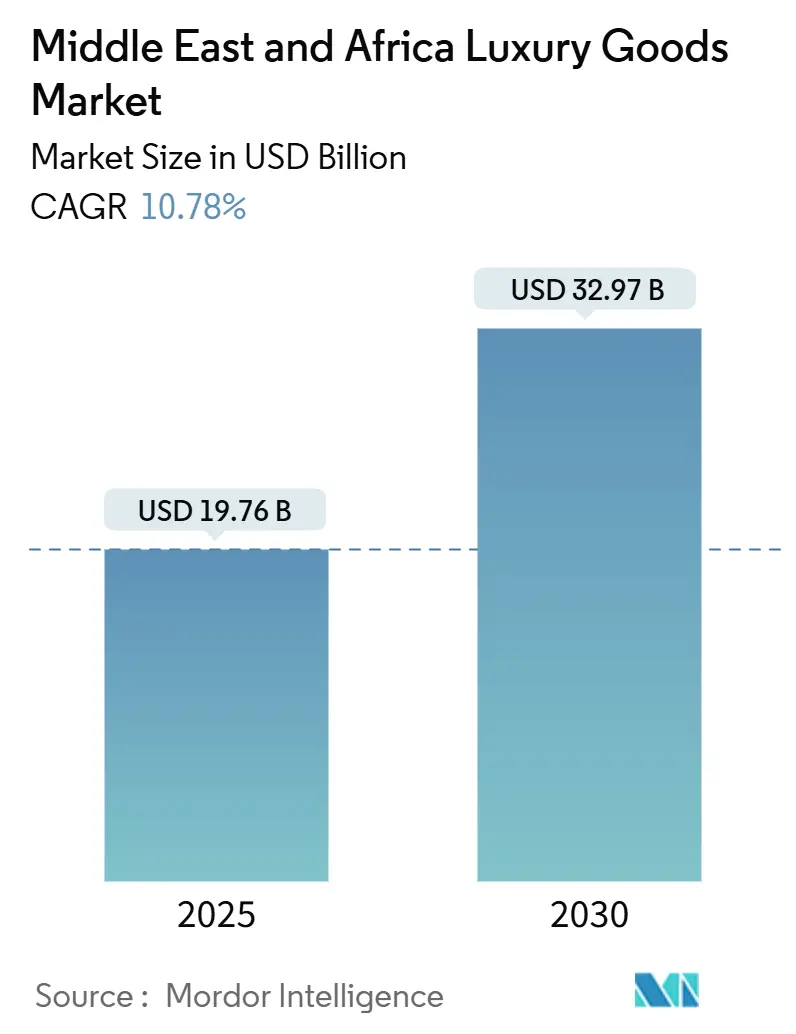
Middle East And Africa Luxury Goods Market Analysis by Mordor Intelligence
The Middle East and Africa luxury goods market is expected to reach USD 19.76 billion in 2025, with projections showing growth to USD 32.97 billion by 2030, reflecting a strong CAGR of 10.78%. This growth is driven by an increasing number of high-net-worth individuals, retail ecosystems supported by tourism, and government efforts to diversify economies. Additionally, the rise of e-commerce and the influence of social media have made luxury goods more accessible to consumers. While European conglomerates continue to dominate the market, regional brands and online-first labels are gaining traction by focusing on cultural authenticity and sustainability. Governments in the Gulf are simplifying customs processes and introducing VAT-refund programs, making the region more appealing for luxury shopping. Meanwhile, countries like South Africa and Nigeria are experiencing higher aspirational spending, contributing to a diverse growth pattern that strengthens the long-term prospects of the luxury goods market.
Key Report Takeaways
- By product type, clothing and apparel led with 37.71% luxury goods market share in 2024; watches are projected to advance at an 11.12% CAGR to 2030.
- By end user, women accounted for 62.64% spending in 2024, whereas men’s purchases are expected to climb at a 12.02% CAGR up to 2030.
- By distribution channel, single-brand stores captured 46.44% revenue in 2024; online luxury platforms are on track for a 13.21% CAGR during 2025-2030.
- By geography, the United Arab Emirates held 36.96% of the luxury goods market size in 2024, while South Africa is set to grow at a 10.94% CAGR through 2030.
Middle East And Africa Luxury Goods Market Trends and Insights
Driver Impact Analysis
| Drivers | (~) % Impact on CAGR Forecast | Geographic Relevance | Impact Timeline |
|---|---|---|---|
| Product innovation in terms of raw material and design | +1.8% | Global, with strongest impact in UAE, Saudi Arabia, Turkey | Medium term (2-4 years) |
| Consumer shift toward sustainable and eco-certified luxury products | +2.1% | UAE, South Africa, Turkey, with spillover to Morocco, Egypt | Long term (≥ 4 years) |
| Tourism-led retail ecosystems | +1.9% | UAE, Saudi Arabia, Morocco, Egypt, Turkey | Short term (≤ 2 years) |
| Influence of social media and celebrity endorsement | +1.2% | Global, with highest penetration in UAE, Saudi Arabia, Nigeria | Short term (≤ 2 years) |
| Expansion of mono-brand boutiques and mall developments | +0.8% | UAE, Saudi Arabia, South Africa, Turkey, Nigeria | Medium term (2-4 years) |
| Consumers' inclination towards limited edition products | +0.6% | UAE, Saudi Arabia, South Africa, with emerging demand in Nigeria, Morocco | Medium term (2-4 years) |
| Source: Mordor Intelligence | |||
Product innovation in terms of raw material and design
Luxury brands are increasingly leveraging material innovation by combining advanced technologies with traditional craftsmanship to create distinctive value propositions. For instance, Goldgenie Dubai plans to launch the 24k Gold iPhone 16 Pro range in July 2025, showcasing a blend of cutting-edge technology and gold craftsmanship aimed at ultra-high-net-worth individuals in the Gulf region. Regional artisans are also collaborating with global luxury brands to incorporate local materials and techniques, crafting authentic products that appeal to culturally-aware consumers. Additionally, companies like Paragon ID are addressing both innovation and anti-counterfeiting concerns by integrating blockchain authentication and RFID solutions into their offerings. This focus on superior materials and technological advancements enables brands to command higher prices while fostering long-term consumer trust. As competition intensifies, brands are accelerating innovation cycles to introduce exclusive materials and limited-production techniques, ensuring their offerings remain unique and difficult for competitors to replicate.
Consumer shift toward sustainable and eco-certified luxury products
Environmentally conscious consumers are driving significant changes in luxury consumption patterns by closely examining brand practices and demanding greater supply chain transparency. Hermès International has responded to these shifting expectations by committing to 100% recycled gold and silver in its workshops and achieving validation from the Science-Based Targets initiative for its emissions reduction goals. African luxury brands are also leveraging this trend by focusing on sustainably sourcing indigenous materials such as shea, frankincense, and myrrh, which helps them build authentic sustainability stories and gain a competitive advantage. Beyond material sourcing, luxury brands are adopting circular economy practices, including repair services, upcycling programs, and policies to avoid destroying unsold inventory. Governments in regions like the United Arab Emirates and Saudi Arabia are supporting this transition by enforcing sustainability disclosure requirements and ESG reporting mandates. Additionally, consumers are willing to pay higher prices for luxury products that are certified as sustainable, creating opportunities for brands that can effectively demonstrate environmental responsibility throughout their value chains.
Tourism-led retail ecosystems
Investments in tourism infrastructure play a crucial role in driving luxury consumption by seamlessly integrating retail, hospitality, and unique experiences. Saudi Arabia's USD 17 billion Red Sea Global project and the "Dream of the Desert" luxury train, set to launch in Q3 2026, are prime examples of government-led efforts to position tourism as a key driver of the luxury market. In 2024, Dubai welcomed over 18.72 million international overnight visitors, supported by VAT refund programs for tourists, showcasing how well-coordinated policies can enhance a destination's appeal to luxury shoppers[1]Department of Economy and Tourism, "Annual Visitor Report 2024", dubaidet.gov.ae. Morocco presents diverse investment opportunities, such as luxury ferry services, yacht rentals, and desert glamping, offering luxury brands multiple ways to engage with various consumer segments. Additionally, the Middle East and Africa Duty Free Association's initiatives to integrate duty-free retail with luxury hospitality maximize revenue potential from international visitors. By creating immersive experiences that go beyond traditional retail, these ecosystems ensure sustained demand for luxury products and services.
Influence of social media and celebrity endorsement
Social media platforms have become a driving force in how luxury brands are discovered and purchased, significantly shaping consumer decisions. In the Gulf and North African markets, regional celebrities and influencers play a vital role by connecting luxury brands with their audiences through culturally relevant content and endorsements. This strategy helps brands build authentic relationships that resonate with local consumers. Increasingly, Arab shoppers are moving away from traditional heritage luxury brands, instead favoring those promoted on social media, where exposure often holds more influence than historical prestige. To keep up with this shift, luxury brands are launching Ramadan capsule collections and collaborating with local influencers to enhance cultural relevance and strengthen consumer connections. Additionally, brands are tailoring their strategies to specific platforms: Instagram and TikTok are key for brand discovery, while WhatsApp and regional platforms are essential for purchase discussions. The measurable success of influencer partnerships is encouraging brands to invest more in social media collaborations and celebrity endorsements that align with regional preferences.
Restraint Impact Analysis
| Restraint | (~) % Impact on CAGR Forecast | Geographic Relevance | Impact Timeline |
|---|---|---|---|
| Proliferation of counterfeit products | -1.4% | Global, with the highest impact in the United Arab Emirates, Morocco, South Africa, Nigeria | Short term (≤ 2 years) |
| Stringent regulatory environment and compliance costs | -0.9% | United Arab Emirates, Saudi Arabia, Turkey, South Africa, with emerging impact in Nigeria, Egypt | Medium term (2-4 years) |
| Supply chain fragility and lead-time variability | -1.1% | Global, with critical impact on Turkey, Morocco, Egypt supply corridors | Medium term (2-4 years) |
| Labor shortages in specialized craftsmanship | -0.7% | United Arab Emirates, Turkey, Morocco, South Africa, with spillover effects to regional markets | Long term (≥ 4 years) |
| Source: Mordor Intelligence | |||
Proliferation of counterfeit products
Counterfeit products damage brand reputation and weaken consumer trust, creating unfair competition that reduces legitimate market share and pricing power. Dubai's Commercial Compliance and Consumer Protection agency recently seized 3.5 million counterfeit goods, highlighting the widespread impact of illicit trade on luxury brand revenues and market positioning[2]Dubai's Commercial Compliance and Consumer Protection, "Major Crackdown: Dubai Seizes 3.5 Million Illegal Goods Worth Dh133m", dubai.ae. Counterfeit activities are often concentrated in major trade hubs and tourist destinations, making it challenging for luxury brands to protect their intellectual property and maintain their exclusive image. To address these issues, brands are increasingly using advanced authentication technologies, such as blockchain solutions for tracking diamonds and verifying luxury goods. While the United Arab Emirates has implemented several anti-counterfeiting laws, enforcement effectiveness varies across regions. Many markets face challenges like limited resources and complex jurisdictional issues. Additionally, the rapid growth of online marketplaces and social media platforms has created new channels for counterfeit distribution, requiring constant monitoring and enforcement. To tackle this, brands are investing in consumer education campaigns to help customers identify authentic products and understand the risks of purchasing counterfeit items.
Stringent regulatory environment and compliance costs
Governments are enforcing stricter compliance regulations in areas such as tax, customs, and data protection, leading to higher operational costs and increased challenges for market entry. In the United Arab Emirates, the introduction of the 12-digit GCC Integrated Customs Tariff has added significant administrative burdens for luxury importers, potentially affecting pricing strategies and disrupting supply chains. Across Gulf markets, stricter corporate tax compliance and transfer pricing rules are pushing luxury brands to reevaluate their tax structures and consider reorganizing their regional operations. Enhanced anti-money laundering and counter-terrorism financing regulations now require brands to adopt advanced systems for customer due diligence and transaction monitoring, increasing both complexity and costs. Additionally, expanding data protection laws in the United Arab Emirates, Saudi Arabia, and Qatar are creating new compliance challenges for brands managing customer data and cross-border transfers. The harmonization of economic substance requirements across jurisdictions further demands consistent alignment and timely reporting to avoid penalties and protect brand reputation in the competitive luxury market.
Segment Analysis
By Product Type: Apparel Dominance Versus Watch Sophistication
In 2024, clothing and apparel hold a 37.71% share of the market, highlighting their strong appeal across various consumer groups. This segment acts as the main entry point for luxury consumption in the growing markets of the Middle East and Africa. The popularity of modest luxury fashion in Gulf countries drives demand, with brands customizing their collections to meet local dress codes while maintaining global design standards. For example, Thebe Magugu's collaboration with Cape Town's Mount Nelson Belmond Hotel showcases how African fashion designers work with luxury hospitality brands to create culturally relevant apparel that appeals to both local and international audiences. The segment's strength is supported by regular seasonal updates, celebrity endorsements, and the influence of social media, which continuously drive interest in new collections and exclusive releases. Additionally, fashion weeks in Dubai and Saudi Arabia provide key opportunities for luxury apparel brands to present their collections, build cultural connections, and engage with consumers in the Middle East.
Watches are the fastest-growing product category, with an 11.12% CAGR projected through 2030. This growth is fueled by the region's cultural appreciation for watches as both investment assets and symbols of status, which remain valued regardless of economic conditions. Brands like Out of Order watches are responding to this demand by creating region-specific collections, such as the Arjwan Edition, designed to reflect Middle Eastern tastes and cultural significance. The category also benefits from active collector communities and secondary markets, particularly in the Gulf, where luxury watches are seen as portable wealth and valuable family heirlooms. To meet rising demand, Swiss and German watchmakers are opening regional service centers and boutiques. Limited editions and intricate watch complications generate excitement and support premium pricing strategies. Furthermore, combining traditional mechanical craftsmanship with modern materials and technologies allows brands to stand out, attracting sophisticated consumers who value authentic luxury experiences.
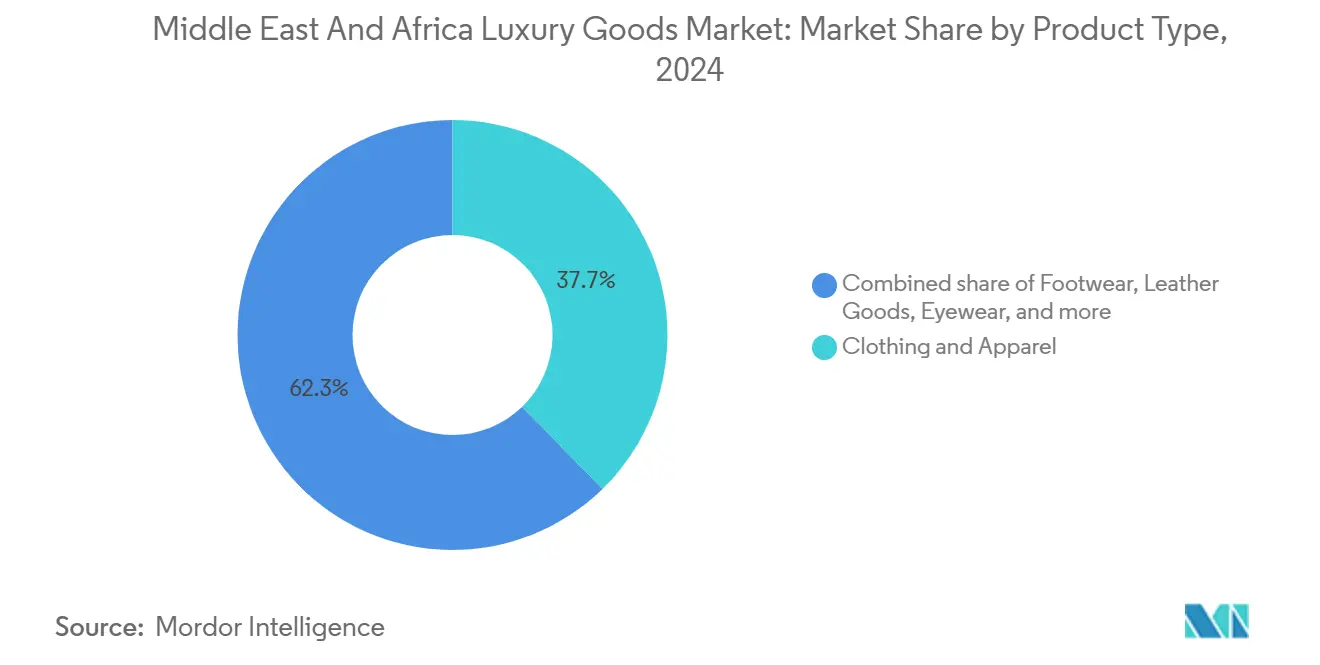
Note: Segment shares of all individual segments available upon report purchase
By End User: Women's Market Leadership Meets Men's Acceleration
In 2024, women lead luxury consumption, making up 62.64% of the market. This dominance is driven by higher workforce participation, growing entrepreneurship, and increasing disposable incomes, particularly in the Middle East and Africa. The luxury market benefits from a wide range of products, including fashion, beauty, jewelry, and accessories, which provide multiple opportunities for brands to engage with customers and build long-term value. Cultural changes in the region, such as Saudi Arabia's Vision 2030 and the UAE's gender balance programs, are promoting women's economic empowerment and boosting their spending on luxury goods. Female consumers are showing a preference for sustainable and ethically-made products that align with their values and social responsibility. Additionally, women are leading the adoption of luxury e-commerce, with social media and peer recommendations playing a key role in their purchasing decisions.
Men's luxury consumption is growing rapidly, with a 12.02% CAGR expected through 2030. This growth reflects changing social norms and greater male participation in fashion, grooming, and lifestyle categories that were traditionally dominated by women. Economic diversification in Gulf countries has created new job opportunities, encouraging men to spend more on luxury business attire, watches, and lifestyle products that signify success and status. The influence of male celebrities and style-conscious influencers in the region is inspiring younger men to invest in luxury items such as fragrances, accessories, and personal care products. Meanwhile, traditional categories like watches and leather goods continue to perform well, supported by cultural appreciation for craftsmanship and heritage brands. The growing acceptance of men's jewelry and grooming products is also expanding the market, offering new opportunities for growth.
By Distribution Channel: Flagship Control Versus Digital Convenience
In 2024, single-brand stores hold a 46.44% market share, offering carefully designed spaces where luxury brands provide unique and immersive experiences. These experiences not only reinforce their premium image but also build strong customer loyalty. Flagship stores act as brand representatives in key markets. For instance, the Mercedes-Benz Place in Dubai represents a USD 1 billion investment in luxury retail and residential development, expected to be completed by 2026. This channel excels by offering personalized services, exclusive product access, and memorable experiences that create emotional connections with customers. In Turkey, luxury shopping destinations like Galataport, İstinye Park, Zorlu Center, and Emaar Mall provide high-end retail spaces. These locations, with their strategic positioning and carefully selected brand offerings, attract both local and international luxury shoppers. Mono-brand boutiques allow luxury brands to control every aspect of customer interaction, leading to higher profit margins and better customer data collection compared to multi-brand retail partnerships.
Online luxury stores are the fastest-growing channel, with a 13.21% CAGR projected through 2030. This growth is driven by increasing digital adoption, the rise of mobile commerce, and changing consumer preferences for convenience and 24/7 shopping access. E-commerce platforms help luxury brands reach customers across different regions while offering personalized shopping experiences. Features like AI-powered recommendations and virtual styling services replicate the in-store experience online. The rapid growth of this channel is supported by secure payment systems and authentication solutions that address traditional concerns about online luxury shopping. Regional initiatives, such as Turkey's 2025-2027 Medium-Term Program focusing on digital infrastructure, create favorable conditions for the online luxury market[3]Invest in Turkey, "Türkiye Releases 2025-2027 Medium-Term Program", invest.gov.tr. Additionally, technologies like augmented reality, virtual try-on tools, and same-day delivery enhance the online shopping experience while maintaining the exclusivity and high service standards associated with luxury retail.
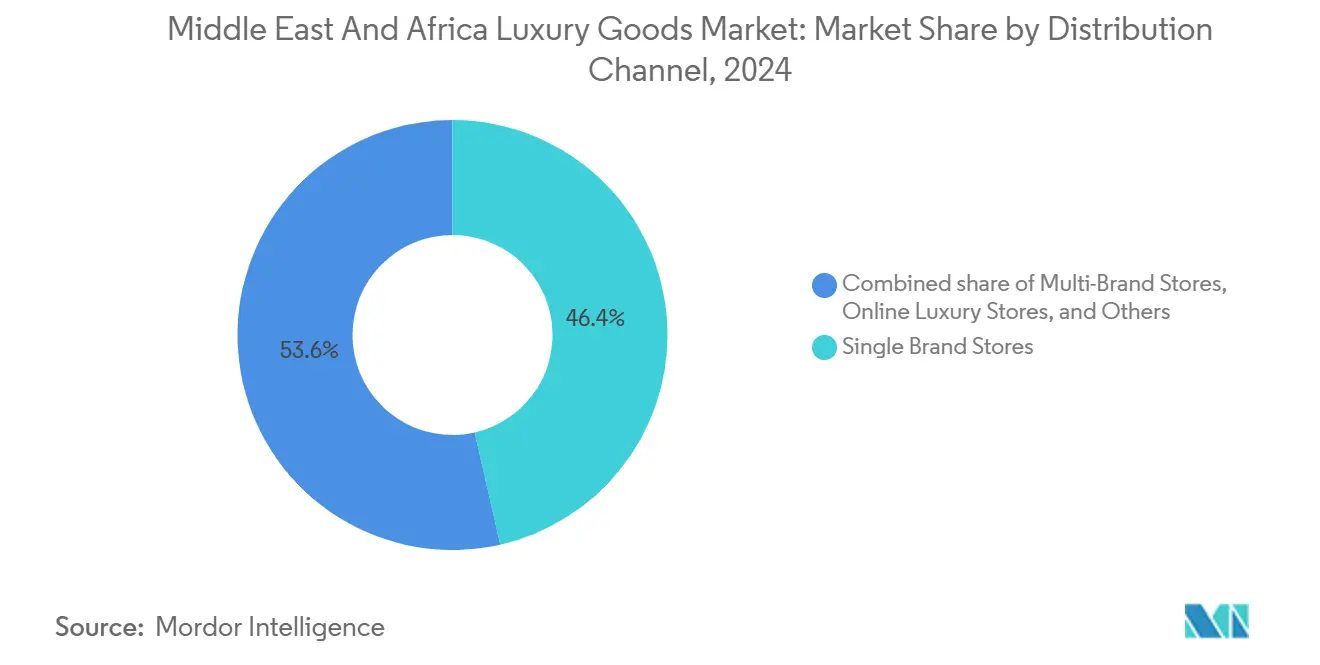
Note: Segment shares of all individual segments available upon report purchase
Geography Analysis
In 2024, the United Arab Emirates (UAE) holds a significant 36.96% market share, driven by Dubai's reputation as a global luxury destination. Strategic government initiatives, such as VAT refund programs, have made shopping tourism more attractive. The use of advanced customs systems and benefits from free trade zones simplify the import and distribution of goods across the Middle East. Hermès International's move to take majority control of its UAE retail operations highlights the market's long-term growth potential and strategic importance.
South Africa is leading regional growth with an impressive 10.94% CAGR projected through 2030. This growth is supported by the expansion of luxury brands like Louis Vuitton, Gucci, and Dolce & Gabbana at Cape Town's V&A Waterfront. These developments reflect the confidence luxury brands have in South Africa's stable economy and growing consumer base. The country’s strong infrastructure, clear regulations, and English-speaking business environment make it an attractive entry point for international brands. Additionally, South Africa serves as a gateway to other African markets through its regional distribution networks. Other countries, including Saudi Arabia, Nigeria, Egypt, Morocco, and Turkey, contribute to growth through factors like economic diversification, tourism investments, a rising middle class, and cultural luxury traditions. The rest of the Middle East and Africa regions also offer growth opportunities through emerging consumer groups, infrastructure improvements, and regional trade integration, which enhance market access and distribution efficiency.
African luxury markets are growing rapidly, supported by an increasing number of high-net-worth individuals, infrastructure development, and a stronger sense of cultural pride. This growth benefits both local luxury brands and international players. South Africa’s luxury retail sector, highlighted by major brand openings at Cape Town's V&A Waterfront, demonstrates the sophistication of local consumers and the country’s role as a gateway to broader African opportunities. In Nigeria, the expanding hotel market, which has the second-largest pipeline in Africa with 50 hotels and 7,622 rooms, creates new opportunities for luxury retail. These include in-hotel boutiques, concierge services, and partnerships for experiential marketing.
Competitive Landscape
The Middle East and Africa luxury goods market exhibits a moderately consolidated competitive landscape. Global brands like LVMH Moët Hennessy Louis Vuitton SE, Compagnie Financière Richemont SA, Kering S.A, and Chanel S.A dominate key segments such as fashion, j, and watches. These companies leverage their global reputation, strong brand equity, and extensive distribution networks to maintain a significant presence in affluent markets like the UAE, Saudi Arabia, and South Africa. At the same time, regional and family-owned businesses play a crucial role, especially in niche areas like perfumes, abayas, and luxury retail linked to hospitality, catering to local preferences and cultural traditions.
In Africa, opportunities are burgeoning in sectors like experiential luxury, sustainable products, and brands that authentically resonate with local cultural values. African luxury brands, by harnessing local materials and traditional craftsmanship, are carving out a niche that rivals established European counterparts. These brands leverage their cultural heritage to create unique offerings that stand out in the global market. This trend is especially pronounced in the fragrance and fashion sectors, where cultural narratives not only resonate with consumers but also foster deep brand loyalty. The growing preference for products that tell a story and reflect regional identity is driving this shift.
International luxury brands are forging strategic alliances with regional players, paving the way for smoother market entries. These collaborations bring invaluable local insights and cultural nuances, bolstering brand acceptance and drawing in customers. By partnering with regional entities, international brands can better tailor their offerings to meet local preferences and expectations. Furthermore, the melding of luxury retail with sectors like hospitality, tourism, and entertainment is unveiling fresh avenues. This holistic approach transcends mere product sales, curating a comprehensive lifestyle experience for consumers, replete with diverse services and offerings. The integration of these sectors not only enhances customer engagement but also creates a synergistic ecosystem that drives growth across multiple industries.
Middle East And Africa Luxury Goods Industry Leaders
-
LVMH Moët Hennessy Louis Vuitton SE
-
Kering SA
-
Prada SpA
-
Compagnie Financière Richemont SA
-
Chanel S.A
- *Disclaimer: Major Players sorted in no particular order
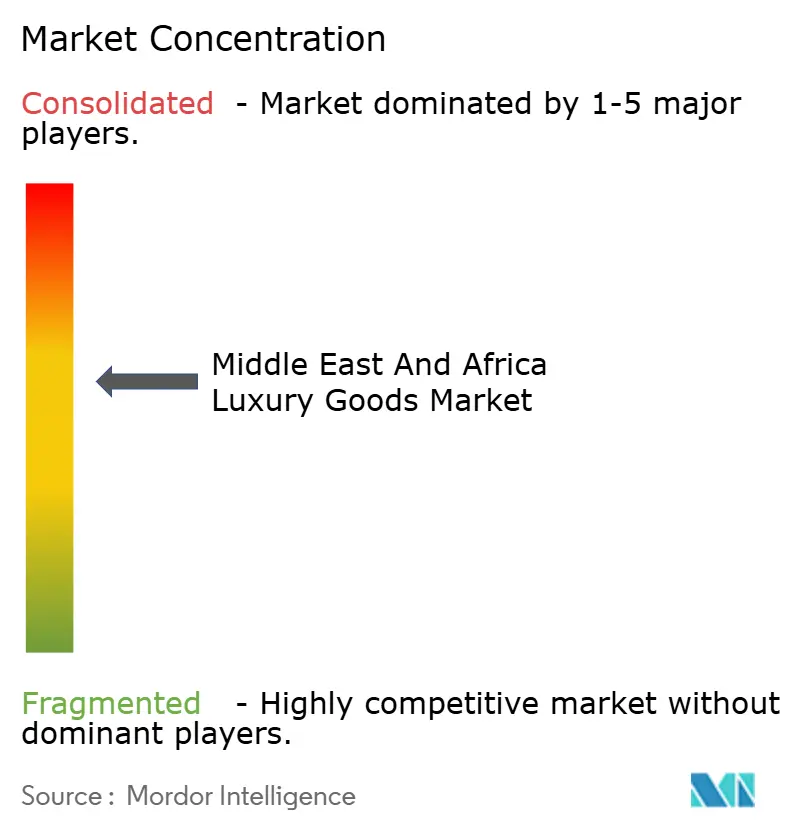
Recent Industry Developments
- September 2025: Casio marked Saudi National Day with the launch of a limited-edition watch that reimagines a classic square-faced model through Saudi cultural motifs, partnering with artist Lina Malaika and fashion label Hindamme to position the watch as a pop-culture icon rather than a mere accessory.
- June 2025: Kalyan Jewellers has expanded its United Arab Emirates footprint to 22 stores by opening two new outlets one in Sharjah and one in Dubai continuing its aggressive growth strategy in the Gulf, aligned with a broader franchise-led expansion plan for FY2025-26.
- April 2025: De Beers introduced its flagship store in the United Arab Emirates at the Dubai Mall. The store showcased unique High Jewellery pieces, crafted to highlight the beauty of the Earth's finest diamonds.
- March 2025: Chic Brand launched an exclusive high-end leather goods and fashion collection in Dubai, positioning a private-label luxury line that fuses traditional craftsmanship with contemporary design to elevate the region’s premium retail experience. The range spans men’s Arabic sandals celebrated across the Gulf Cooperation Council alongside boots, formal shoes, and smart-casual options, plus women’s exotic leather handbags, footwear, and more.
- February 2025: L'Oréal announced its acquisition of a minority stake in Amouage, an esteemed Omani luxury fragrance brand, as part of its efforts to enhance its luxury portfolio. This collaboration was intended to support Amouage's global growth while maintaining its rich heritage and artisanal expertise.
Middle East And Africa Luxury Goods Market Report Scope
Luxury goods are premium, high-quality products that are not necessary for living but add value to consumers' appearance.
The Middle East and African luxury goods market is segmented by product type, distribution channel, and country. By product type, it is segmented into clothing and apparel, footwear, bags, jewelry, watches, and other accessories. The manufacturers operating in this segment are adopting various distribution networks to increase their consumer base, including single-branded stores, multi-brand stores, online retail stores, and other distribution channels. The market is thoroughly studied for different countries under the region, such as the United Arab Emirates, Saudi Arabia, Qatar, South Africa, and the Rest of the Middle East and Africa.
For each segment, the market sizing and forecasts have been done based on value (in USD).
| Clothing and Apparel |
| Footwear |
| Leather Goods |
| Watches |
| Jewellery |
| Eyewear |
| Other Product Types |
| Men |
| Women |
| Unisex |
| Single-Brand Stores |
| Multi-Brand Stores |
| Online Luxury Stores |
| Other Distribution Channels |
| South Africa |
| Saudi Arabia |
| United Arab Emirates |
| Nigeria |
| Egypt |
| Morocco |
| Turkey |
| Rest of Middle East and Africa |
| By Product Type | Clothing and Apparel |
| Footwear | |
| Leather Goods | |
| Watches | |
| Jewellery | |
| Eyewear | |
| Other Product Types | |
| By End User | Men |
| Women | |
| Unisex | |
| By Distribution Channel | Single-Brand Stores |
| Multi-Brand Stores | |
| Online Luxury Stores | |
| Other Distribution Channels | |
| By Geography | South Africa |
| Saudi Arabia | |
| United Arab Emirates | |
| Nigeria | |
| Egypt | |
| Morocco | |
| Turkey | |
| Rest of Middle East and Africa |
Key Questions Answered in the Report
How large is the luxury goods market in Middle East and Africa in 2025?
The luxury goods market size stands at USD 19.76 billion in 2025 and is projected to climb to USD 32.97 billion by 2030.
Which country holds the largest share of regional luxury sales?
The United Arab Emirates leads with a 36.96% share thanks to Dubai’s destination shopping appeal and supportive VAT-refund policies.
What is the fastest-growing product category?
Luxury watches outpace other segments with an 11.12% CAGR forecast through 2030, reflecting their status as both assets and status symbols.
How quickly are online luxury channels expanding?
Online platforms are forecast to grow at a 13.21% CAGR, driven by mobile commerce adoption and AI-enabled personalization.
Page last updated on:
